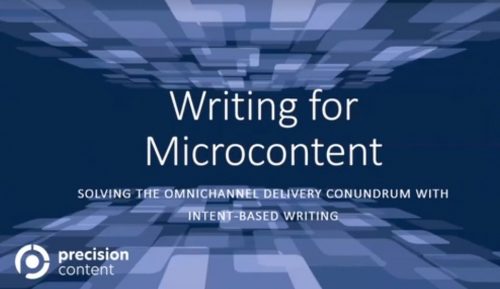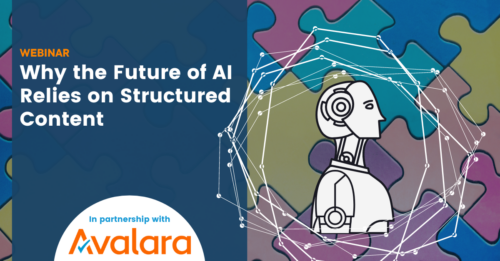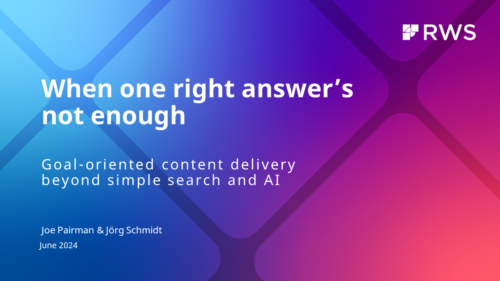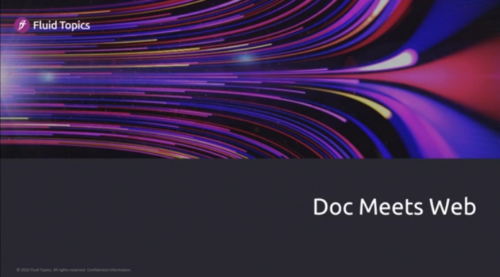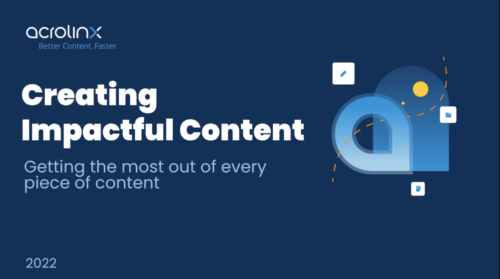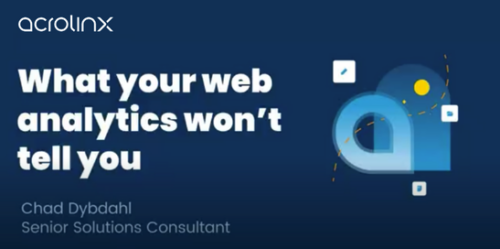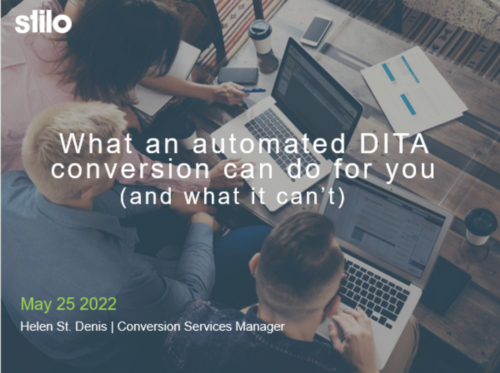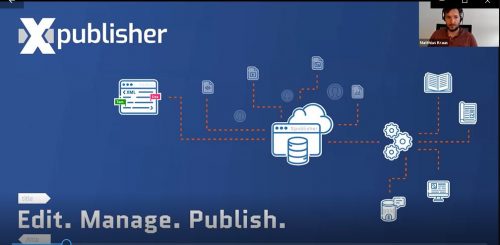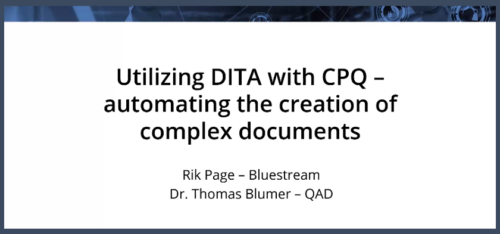-
Recorded on October 26, 2023

Comparing XSL-FO and CSS formatting is not straightforward. XSL implementations are not standing still: XSL formatters are still incrementally improving even though the XSL Recommendation has not been updated since 2006. CSS is definitely not standing still, although some of the modules most relevant to paged media are advancing slowly, if at all, and some paged media features have been removed in more recent Working Drafts.
This will be a high-level view of the differences and similarities between XSL-FO and CSS, based on an extensive new analysis by Antenna House while producing the book “XSL-FO/CSS Comparison” that itself is formatted identically using both XSL-FO and CSS. It also covers some of the features of how the two versions are produced.
Presented by Michael Miller
Michael Miller is Vice President of Antenna House, Inc., a company that has developed one of the leading standards‐based (XSL‐FO and CSS) document formatting software products on the market today. Michael has a degree in Printing Engineering and Management and has been involved in high‐end composition, document formatting, and document management for over 40 years. He has an extensive background with structured data, including SGML, XML, S1000D, and DITA. During his career, he has worked in Europe and North America and has been involved in the implementations of some of the largest fully automated publishing and document formatting projects.
-
May 19, 2021 Omnichannel experience is setting the bar for customer expectation and it’s putting new and increasingly complex demands on your business to deliver the right information where your customers need it. Writing for the web is not writing for omnichannel. Preparing your content for emerging technologies requires new approaches to content creation and delivery. It requires a microcontent strategy. Robust content management technology is certainly part of the solution, and your organization will be tempted to invest in new tools for chatbots and voice. However, before you go ahead and fill yet another content silo with zettabytes of information, instead make enhancements to the content creation programs you already have. Microcontent is the next evolution in structured authoring and will open new channels for your content while improving delivery across existing channels. In this session, we will focus on the missing link in a successful microcontent strategy: an intent-based writing methodology. We will highlight some key concepts that will help you to start looking at your content through an omnichannel lens. Presented by: Mike Rowlinson is the VP of Training & Content Services at Precision Content. Mike has been working in the technical communications industry since 2005. His core belief is that great content enables great companies. Mike’s division develops and delivers engaging and effective training and transformation engagements including the recent completion of the firm's eLearning product, the 15 modules self-paced, Precision Content® Writer Training. The training enables writers to create effective content so that staff and customers alike can find what they need and understand what's required quickly and efficiently.
-
January 12, 2022 Moving to structured authoring and implementing a CMS are critical projects that will generate long-term efficiency gains and significant savings. But before you get there, there are great hurdles to overcome. First and foremost, there's winning budget approval from your execs, who will have a singular focus on risk and ROI. Second, you need to maintain a high level of commitment and buy-in from those executives over the years that re-engineering of content production can last. Too many content restructuring projects fail or don’t even start because they cannot demonstrate a quick and tangible return on investment - and this is where Dynamic Content Delivery changes the game. Dynamic Content Delivery provides outstanding content experiences to your users and creates immediate value for your company without requiring a big bang in your writing process. It earns you internal support, money, and time you can leverage to optimize your content restructuring process. In this webinar, you will learn:
- How Dynamic Content Delivery generates value from your existing content, no matter the writing tools and methods you are using now
- How to achieve quick wins and build a fast ROI to gain support from your Execs for your content project
- How to optimize your project to move to structured authoring and make it a success
-
Recorded: April 20, 2022
 Presented by Géraldine Boulez
Your technical documentation is one of your company’s most valuable assets. The bad news is: your execs and most of the other departments in your organization don’t know about it. Even worse, some even consider tech content as an unproductive cost and try to cut it to a minimum.
Still, your documentation can achieve your company’s most critical goals in all customer-facing areas, and it’s high time your organization understood and embraced the business opportunity brought by tech doc.
In this webinar, you will learn:
Presented by Géraldine Boulez
Your technical documentation is one of your company’s most valuable assets. The bad news is: your execs and most of the other departments in your organization don’t know about it. Even worse, some even consider tech content as an unproductive cost and try to cut it to a minimum.
Still, your documentation can achieve your company’s most critical goals in all customer-facing areas, and it’s high time your organization understood and embraced the business opportunity brought by tech doc.
In this webinar, you will learn:
- How to debunk the most common misconceptions about the business value of tech doc
- How to connect your tech content to your company’s business goals
- and how to demonstrate to your execs how your documentation can effectively generate gains in three main areas of business: Marketing, Customer Support, and Field Services.
Presented by:
Géraldine is passionate about new technologies and their ability to solve people and business problems. This is what has led her to product management, marketing and business development positions in fast-growing tech companies and innovative corporations for over twenty years. Geraldine is VP of Marketing at Fluid Topics, the leading Content Delivery Platform that reinvents how users search, read and interact with technical documentation.
-
Recorded on: January 24, 2024

Improve Efficiency and Reduce Risk with High-Quality Componentized Content
Presented by: Chris Carroll, Acrolinx; Mike Iantosca, Avalara; and Dipo Ajose-Coker, Madcap SoftwareIn this webinar, we’ll dive into the strategies and practical solutions to help technical writing teams and enterprise content owners to improve editorial workflows and manage the risks associated with generative content. In this session we’ll discuss:- Why enterprises should consider relational componentized content
- Recommendations enterprise content teams should follow to measure success
- How Avalara is increasing content efficiency and customer experience
 Chris Carroll is Director of Product Marketing at Acrolinx.
Chris Carroll is Director of Product Marketing at Acrolinx.
 Mike Iantosca is Senior Director of Content Platforms at Avalara.
Mike Iantosca is Senior Director of Content Platforms at Avalara.
 Dipo Ajose-Coker is Product Marketing Manager at MadCap Software.
Dipo Ajose-Coker is Product Marketing Manager at MadCap Software.
-
Recorded on June 5, 2024

Delivery of tech docs often focuses on search — getting users to a good starting place. But users often have goals that a single page can’t cover. Serious tasks can require reference info, scenarios, and guidance. Users may need information in different media. Each user’s goal depends on their specific context, and they need to follow a unique path through the information. Writers cannot possibly design content for all of those users, with all of their unique paths.
Many of the ways that people have tried have failed. At various times, tech docs have relied more on search, or more on manual hyperlinks, or taxonomy. Pages have been long or short, other media have gone and come. Now AI offers easier ways to map content together, but even that’s not enough. Why?
Only a combination of techniques will give you the information model that you need. And the techniques on their own won’t get you all the way — you need an integrated design to bring your solution together. Learn how.
Key takeaways of this webinar will be: - The real needs of complex tasks for users, and how to map them to usable metadata. - What AI can do to suggest appropriate content — and what it can’t - How to design a suitable goal-enabling solution for your own organization’s needs
Join in with Joe Pairman, Director of Product Management, RWS Group and Jörg Schmidt, Senior Solutions Architect, RWS Group to find out more.
Presented by: Joe Pairman, Director of Product Management, RWS
Joe Pairman, Director of Product Management, RWS
Joe is Director of Product Management for Tridion. He is currently shaping strategic design for a more accessible and impactful product, drawing on his experiences leading teams and bringing structured content operations to tech companies, banks, and pharma companies.
 Jörg Schmidt, Senior Solutions Architect, RWS
Jörg has been working in multiple roles for different CCMS providers for more than 20 years. During that time, he has helped defining and implementing solutions in verticals like machinery, automotive, A&D - but also pharma & finance. Since 2013, he has been working for RWS as a Solution Architect.
Jörg Schmidt, Senior Solutions Architect, RWS
Jörg has been working in multiple roles for different CCMS providers for more than 20 years. During that time, he has helped defining and implementing solutions in verticals like machinery, automotive, A&D - but also pharma & finance. Since 2013, he has been working for RWS as a Solution Architect.
-
Recorded on September 28, 2022
 Most tech doc websites are barely usable.Why is that? For most people, moving from paper-based documentation to delivering technical content on the web is nothing but generating HTML pages that will turn into a website. But this simplistic view overlooks the difficulties stemming from the specificities of technical documentation and misses the usability and interactivity gains offered by a true digital transformation of tech doc.This webinar will uncover the intricacies of transitioning to a web-based documentation and the cultural and technological clashes it represents. We will carve out the different options you need to consider and the technical choices you need to make, how they vary according to your strategic goals, your corpus of content, and your audience, giving you some key insights for successfully achieving your content digital transformation.
Most tech doc websites are barely usable.Why is that? For most people, moving from paper-based documentation to delivering technical content on the web is nothing but generating HTML pages that will turn into a website. But this simplistic view overlooks the difficulties stemming from the specificities of technical documentation and misses the usability and interactivity gains offered by a true digital transformation of tech doc.This webinar will uncover the intricacies of transitioning to a web-based documentation and the cultural and technological clashes it represents. We will carve out the different options you need to consider and the technical choices you need to make, how they vary according to your strategic goals, your corpus of content, and your audience, giving you some key insights for successfully achieving your content digital transformation.Presented by Fabrice Lacroix
 Fabrice Lacroix is a serial entrepreneur and a technology pioneer. He has been working for 25 years on the development of innovative solutions around search technology, content enrichment and AI. He is the founder of Fluid Topics, the leading Content Delivery Platform that reinvents how users search, read and interact with technical documentation.
Fabrice Lacroix is a serial entrepreneur and a technology pioneer. He has been working for 25 years on the development of innovative solutions around search technology, content enrichment and AI. He is the founder of Fluid Topics, the leading Content Delivery Platform that reinvents how users search, read and interact with technical documentation. -
Recorded: June 8, 2022
 Content fuels your business. It has a purpose and an expected outcome: Deeper engagement. Higher conversions. Fewer support tickets. The list goes on.
But does your content live up to its expectations? And if not, what can you do about it?
Join Chris Willis, Acrolinx CMO, as he explores the importance and value of content impact. You’ll learn:
Content fuels your business. It has a purpose and an expected outcome: Deeper engagement. Higher conversions. Fewer support tickets. The list goes on.
But does your content live up to its expectations? And if not, what can you do about it?
Join Chris Willis, Acrolinx CMO, as he explores the importance and value of content impact. You’ll learn:
- What impactful content looks like and if yours qualifies
- Why content impact outperforms basic quality to deliver better business results
- How technology can help you automate your content improvement
 Christopher P Willis is Acrolinx’s Chief Marketing Officer, responsible for all aspects of the company’s Marketing strategy. Christopher is a specialist in Content Impact, AI, and pipeline management with over 20 years of experience growing companies in the technology sector. Before joining Acrolinx, Christopher held leadership roles in marketing, creative, technical, and business development at companies including Perfecto, Pyxis Mobile, KPMG-CT, ModelGolf, and Cambridge Technology Group. Willis is a recognized thought leader in the areas of AI, DEI and Content Impact, and is active within industry groups dedicated to the growth and health of Marketing Technology and the verticals he serves. Also, this year, Willis received a Top 100 Marketer Award in the 2022 OnCon Icon Awards.
https://www.linkedin.com/in/cpwillis
Christopher P Willis is Acrolinx’s Chief Marketing Officer, responsible for all aspects of the company’s Marketing strategy. Christopher is a specialist in Content Impact, AI, and pipeline management with over 20 years of experience growing companies in the technology sector. Before joining Acrolinx, Christopher held leadership roles in marketing, creative, technical, and business development at companies including Perfecto, Pyxis Mobile, KPMG-CT, ModelGolf, and Cambridge Technology Group. Willis is a recognized thought leader in the areas of AI, DEI and Content Impact, and is active within industry groups dedicated to the growth and health of Marketing Technology and the verticals he serves. Also, this year, Willis received a Top 100 Marketer Award in the 2022 OnCon Icon Awards.
https://www.linkedin.com/in/cpwillis -
Recorded on January 26, 2023
 Traditional web analytics are an invaluable tool that can help you understand how your content is performing in the real world — but they often don’t tell the whole story. Site visitors, time on page, and bounce rate numbers tell you what is happening, but they miss one critical detail: why.
In this discussion, learn how collecting qualitative analytics about your content can help drive more actionable feedback by adding a third dimension to the insights you receive about your content.
Here are the key takeaways:
Traditional web analytics are an invaluable tool that can help you understand how your content is performing in the real world — but they often don’t tell the whole story. Site visitors, time on page, and bounce rate numbers tell you what is happening, but they miss one critical detail: why.
In this discussion, learn how collecting qualitative analytics about your content can help drive more actionable feedback by adding a third dimension to the insights you receive about your content.
Here are the key takeaways:
- Why traditional web analytics only tell part of the story
- How consistently aligning content with your brand identity impacts the bottom line
- Types of qualitative analytics and their impact on content performance
 Chad Dybdahl is a Senior Solutions Consultant with Acrolinx, based out of his home in Wisconsin. He has more than a decade of experience managing enterprise content and loves music and collecting and restoring vintage hi-fi gear. He spends entirely too much time on home automation projects and loves gadgets of all kinds.
LinkedIn profile: linkedin.com/in/chad-dybdahl
Chad Dybdahl is a Senior Solutions Consultant with Acrolinx, based out of his home in Wisconsin. He has more than a decade of experience managing enterprise content and loves music and collecting and restoring vintage hi-fi gear. He spends entirely too much time on home automation projects and loves gadgets of all kinds.
LinkedIn profile: linkedin.com/in/chad-dybdahl
-
Recorded: May 25, 2022
 Presented by Helen St. Denis
Pretty easily, we can get a basic DITA structure from headings, tables and lists in the legacy content. As well, though, for each different source format there are a number of ways to extract information that can be used to refine the DITA output. Likewise, there are ways to enrich the content automatically.
There are, however, some things it can’t do… yet.
As more and more types of content are being moved to DITA, a greater variety of legacy formats need to be converted. We’ll look at some of them to see what can be gleaned from each, beyond the basic structure, and some of the challenges that remain.
Presented by: Helen St. Denis
Helen started at Stilo over twenty years ago as a technical editor. As Conversion Services manager, she’s helped customers convert millions of pages of content to DITA, and worked with organizations with many different approaches to, and reasons for, the move to structured content.
Presented by Helen St. Denis
Pretty easily, we can get a basic DITA structure from headings, tables and lists in the legacy content. As well, though, for each different source format there are a number of ways to extract information that can be used to refine the DITA output. Likewise, there are ways to enrich the content automatically.
There are, however, some things it can’t do… yet.
As more and more types of content are being moved to DITA, a greater variety of legacy formats need to be converted. We’ll look at some of them to see what can be gleaned from each, beyond the basic structure, and some of the challenges that remain.
Presented by: Helen St. Denis
Helen started at Stilo over twenty years ago as a technical editor. As Conversion Services manager, she’s helped customers convert millions of pages of content to DITA, and worked with organizations with many different approaches to, and reasons for, the move to structured content. -
March 17, 2021 Xeditor is a professional online XML editor based on state-of-the-art web standards. With Xeditor, structured, semantically correct content in XML format can be created intuitively, efficiently and without technical knowledge. By enabling authors to work together on structured content from any location at any time, Xeditor helps companies put efficient workflows in place. This way, companies are able to take advantage of all the benefits of standardized content - such as automated further processing - without the need for costly training for authors. Presented by: Matthias Kraus is the founder and managing director of Xpublisher GmbH. Since 2001, he has been advising numerous leading international companies and organizations from the aerospace, technology, education, publishing, public administration and many other industries in the field of multi-channel publishing and accompanying them on their way to digitization.
-
Recorded on October 5, 2022
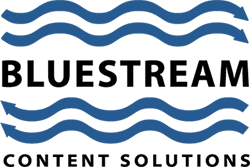 CPQ systems are just one of several business systems that can be enhanced with the content stored within your CCMS. Thomas and Rik will drill down into this with real-world examples of multiple deployments, including QAD’s own experience. They will discuss the pros and potential pitfalls of these combined systems and explore the best approach to take to maximize their success.
Presented by:
Thomas Blumer, QAD
CPQ systems are just one of several business systems that can be enhanced with the content stored within your CCMS. Thomas and Rik will drill down into this with real-world examples of multiple deployments, including QAD’s own experience. They will discuss the pros and potential pitfalls of these combined systems and explore the best approach to take to maximize their success.
Presented by:
Thomas Blumer, QAD
Dr. Thomas Blumer is the Director of Knowledge Management at QAD. He has a Doctorate in Business Administration with a focus on Knowledge Transfer in M&A Integrations. In his current role, Thomas is delivering enterprise-wide Knowledge Management initiatives focused on collaborating, accelerating best practices, and leveraging internal organizational knowledge. Thomas' main focus is to provide customers, partners, and QAD employees with the right product knowledge, at the right time and at the right place.
Over the last 30 years, Thomas has worked for several Fortune 500 companies such as HP, UBS, and Sharp and implemented or enhanced knowledge base systems, subject matter expert yellow page systems, and communities of practice.
 Rik Page, Bluestream.
Rik has worked with component content and document management solutions for over 20 years. He has worked with custom DTDs and Schemas, S1000D, iSpec2200, and DITA, together with various document and content management systems, including Documentum, SharePoint, XDocs, Ixiasoft, easyDITA, Astoria, and Vasont.
His practical experience ranges from high volume data capture and content creation to dynamic multichannel delivery in various industries, including banking and finance, manufacturing, central government, and education. In addition, Rik has participated in multiple consultancy projects and helped formulate innovative solutions throughout Europe and North America.
Rik is also an advocate of Documentation 4.0, a new concept reflecting the demands on content/documentation that results from moving to Industry 4.0 and ‘smart’ manufacturing.
Rik Page, Bluestream.
Rik has worked with component content and document management solutions for over 20 years. He has worked with custom DTDs and Schemas, S1000D, iSpec2200, and DITA, together with various document and content management systems, including Documentum, SharePoint, XDocs, Ixiasoft, easyDITA, Astoria, and Vasont.
His practical experience ranges from high volume data capture and content creation to dynamic multichannel delivery in various industries, including banking and finance, manufacturing, central government, and education. In addition, Rik has participated in multiple consultancy projects and helped formulate innovative solutions throughout Europe and North America.
Rik is also an advocate of Documentation 4.0, a new concept reflecting the demands on content/documentation that results from moving to Industry 4.0 and ‘smart’ manufacturing.


